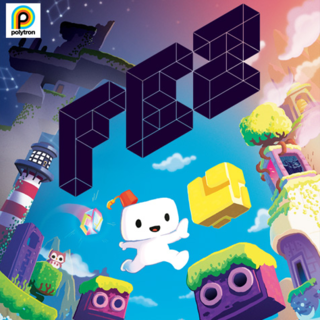Fez is charming, haunting, and challenges one to dig deep into its world and one's self for answers.
Gomez is a small, white marshmallow-like character who lives in a simple village with people of his kind. One morning he awakes, enters a room, and there is crowned with a red hat called Fez. He finds himself waking again, but this time, because of Fez, he is able to rotate the village he lives in and explore all of its dimensions. A floating, talking cube accompanies Gomez to aid him in his journey of finding mysterious cubes. It is not clear as to why collecting these cubes are important, but one thing is for certain: obtaining all of them is not easy.
When Gomez collects around a half-dozen cube shards, it becomes one cube. The shards are usually the least difficult to collect; they are sometimes hidden in places that are hard to reach, but for the most part, manipulating the fray or doing some platforming (sometimes tricky) is all that is needed. Some full cubes are obtained by simply discovering a room or traversing platforms. There is no set or progression of difficulty in Fez. The enormous world is broken into many sections which contain numerous doors; some contain one or two while others contain more than several. Doors are usually more abundant in main sectors. Doors in the main sectors lead to new areas that have puzzles and sometimes more doors which lead to more sub-sectors, puzzles, and doors. Behind some doors are only small, empty rooms. There is no way to predict or even expect what you are about to encounter when entering into a new area. It may be a simple platforming segment, an area with a challenging puzzle, or a place with odd symbols scattered across walls and rocks.
Usually, puzzle games give the player some hint as to what they are supposed to be doing. In Fez, one may enter a new area, see hundreds of symbols, bizarre characters, and other suspicious objects and have no idea as to what any of it means, if anything. In one area, a giant bell is situated on a hill. Gomez can ring it, but how many times is he supposed to ring each of the four sides, if at all? One town is filled with neon signs, one of which is a large, glowing owl. Most of the signs have various shapes and lines on them, but what does it mean. Is it useful? If so, for what? As one spends more time with the game, he will discover some themes that reoccur, but some puzzles simply require one to think differently and use some outside resources if necessary: paper, pen, a guide?
Many will resort to an online guide for help on this one. Some puzzles would literally take hours on end to figure out, if ever. Gomez's block buddy will, at times, say something regarding a new discovery, but it is mostly always useless: "I wonder what this means?", "What is this?", "Oh, I forgot what this thing is." In rare occasions he will say something that provides a clue, but even in those moments it is very implicit and easy to miss.
The rotating ability plays a vital role in most of the puzzles, but also in platforming. Gomez must jump, climb vines and ladders, and rearrange platforms to fully explore the world. Some intriguing concepts make their way into the platforming side of Fez. For example, one area contains small rectangular objects on the ground with handles sticking out of both sides. Gomez can grab a handle and turn it, causing the entire fray to rotate. A red-striped pole rises from the middle of the square, and the walls nearby flip inside-out. The walls, now outwardly their vine covered inner parts, can be climbed, but Gomez must do so before the pole goes back into the ground. It does not sound exciting in words, but the actual concept and experience is worthy of recognition.
For a two-dimensional side-scroller, calling Fez "enormous" is a bit of an understatement. There are literally more than a hundred different areas to discover. Thankfully, there is a map: a three-dimensional map that can be a bit cluttered and difficult to read, but it's sufficient. The map does show you if a room contains a secret (question marks appear beside rooms), a treasure, locked door, small gate, warp gate, or a cube. Warp gates are usually found atop prime sectors, and there is no way to warp to any previous main area, but only to whatever three areas that specific warp gate provides. Small gates only warp to one specific area. Traveling through Fez's world can be time consuming and tedious, but more times than not, retreading old paths opens up the possibility of accessing previously hidden, overlooked, or blocked places. Secrets and rewards abound in Fez, but one will reap according to his efforts.
Backtracking is made easier since Fez is easy on the eyes and ears. It has a retro look, but aesthetically, it is a gorgeous game. The settings range from relaxing and charming to dark and creepy. One of the most delightful areas is one that contains a bridge and lighthouse surrounded by water. There is one sector that is always drenched in rain and bombarded by thunders and lightnings. What looks like a huge Catholic Church is there, and there are crosses, tombstones, owls, and even ghosts. The scenery is made all the more beautiful by the exceptional soundtrack. Fez contains a variety of phenomenal tunes: slow electronic beats, deep, dreadful organs, depressing synthesizers, shimmering violins and humming harps.
For only ten dollars (800 Microsoft Points), Fez offers up a unique, gratifying and exhausting experience. Only those who truly want a hearty challenge that requires more than surface level thinking and mild curiosity should dive into Fez. Everyone else should at least try it if only to experience its imaginative universe.

